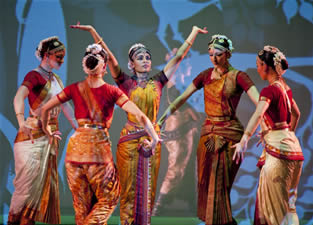Asheville, a city teeming with its unique brand of energy and creativity, seems a fitting place to launch a new music festival. The Asheville Amadeus Festival, which pays homage to Mozart’s genius with both high-brow and whimsical events, culminates in a final concert by the Asheville Symphony with renowned pianist Emanuel Ax. For this opening concert, the Asheville Chamber Music Series partnered with festival organizers to present the Brentano Quartet with assisting violist Hsin-Yun Huang. A sold-out house packed the Diana Wortham Theatre, easily breaking an attendance record for any single event sponsored by the Asheville Chamber Music Series in its 62-year history.
What better way to pay tribute to the master than with two works for strings he not only composed but also probably enjoyed playing! Sandwiched between his String Quartet No. 17, in B flat, K.458 (“The Hunt”), and the String Quintet, No. 3, in C, K.515, was Brahms’ String Quartet No. 3, Op. 67, a work that emulates Mozart’s “Hunt” quartet by the utilization of the same key and “horn call” motives in its opening movement. Founded in 1992, the Brentano Quartet includes violinists Mark Steinberg and Serena Canin, violist Misha Amory, and cellist Nina Lee. Joining them for the Mozart Viola Quintet was violist Hsin-Yun Huang.
This is one of the very finest quartets I have heard. Lack of space here precludes detailing their numerous accolades and vast experience as concert artists, artists-in-residence, and creative projects, so I recommend visiting their website for this information. Their strengths as players and interpreters are numerous: the perfect synchronization of each bow stroke, each inflection, and voicing. While they are greatly passionate players, they do not distract from their performance with excessive gesturing and are especially adept at plumbing the depths of the quiet end of the dynamic spectrum.
The program opened with Mozart’s “Hunt” Quartet, a piece redolent of nature, with its charming horn call motives encased within elegantly shaped phrases. The ensemble did not overplay this work, but kept it at a generally restrained dynamic level, combining introverted elegance with extroverted exuberance. The Adagio movement showcased in particular their uncanny ability to synchronize the slightest bits of tempo variance with perfectly timed entrances.
Following this was the Brahms quartet, a work that seemed to generate more music than could be played by four players. On the heels of the Mozart, this work is striking for its complex rhythms, intricate contrapuntal workings, and great swells of intensity, which the ensemble performed with finesse. The execution of the beautiful principal theme of the second movement (Andante) by the first violinist was simply stunning, and the whole ensemble worked beautifully together to create moments of great pathos. The third movement was noteworthy for the dialogue between the violist and violinist amid a sea of rhythmically unsettling, agitated figures played in the other instruments. The fourth movement was a bravura variation set, where the consensus of interpretation was both delicately and boldly wrought.
The final work on the program was the Viola Quintet, with Huang playing second viola. Composed in the spring of 1787, it is one of several fine viola quintets Mozart composed, firmly establishing the genre into the string repertory. The ensemble maintained an admirable and ever flexible balance among the five parts, with each voice easily heard despite the darker timbre. Even though this was last on the program, the energy, interpretive flair and attention to detail were of the finest caliber. Bravi tutti!
That aforementioned final concert in this festival, by the ASO, will be given on March 22, for details of which, click here. For all festival events, click here.













